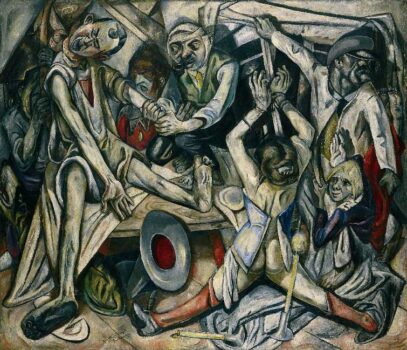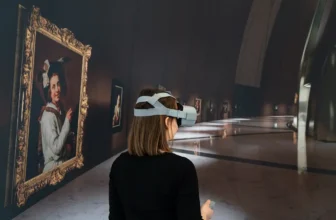Meaning of The Night Painting by Max Beckmann
Few works of art embody the raw, visceral trauma of a society unraveling under the weight of war, violence, and existential dread like “The Night” (Die Nacht) by Max Beckmann. Painted in 1918–1919, at the end of World War I, this nightmarish tableau remains one of the most powerful pieces of German Expressionism and a chilling reflection of the period’s collective psyche. Far more than a mere depiction of suffering, The Night is an allegory of civilization in collapse, a brutally honest confrontation with inhumanity, and a harrowing representation of personal and national trauma.
This essay delves deeply into the painting’s origins, symbolism, meaning, visual elements, artistic context, and historical significance. We will examine who painted it, why and how it was painted, what it represents, what’s happening in the scene, the type of art it exemplifies, and where the painting is located today.
Who Was Max Beckmann?
Before diving into the painting, it’s essential to understand the man behind it. Max Beckmann (1884–1950) was a German painter, draftsman, printmaker, and writer whose work bridged Impressionism, Expressionism, and New Objectivity (Neue Sachlichkeit). Though often associated with Expressionism, Beckmann rejected the label, believing his work was rooted more in realism and a personal symbolic vocabulary than in the emotional distortion of form and color typical of his contemporaries.
Beckmann’s experience as a medical orderly during World War I profoundly affected his psychological state and artistic output. The trauma he witnessed on the front lines , death, disfigurement, madness , would haunt him for years and become central to many of his most famous works, including The Night. Following a mental breakdown in 1915, Beckmann was discharged from military service. He turned increasingly inward, developing a stark and brutal artistic style that abandoned earlier influences of Impressionism and Romanticism in favor of bold, jagged forms and ominous subjects.
When and How Was “The Night” Painted?
“The Night” was painted between 1918 and 1919, in the immediate aftermath of World War I. Germany was in ruins, and the Weimar Republic had just been declared. Political instability, economic collapse, and cultural nihilism pervaded society. The war had shattered not only Europe’s physical landscape but also its moral and philosophical foundations.
During this period, Beckmann was living in Frankfurt, working through his trauma and reconciling it with his role as an artist. The Night emerged as part of this therapeutic and philosophical struggle , a rejection of the ideals of heroism, order, and rationalism that had justified the war. Technically, Beckmann employed oil on canvas, using a tight, angular composition and dense symbolic layering. His approach to space and form was almost claustrophobic, creating an unsettling visual effect that mirrors the psychological tension within the scene.
What is Happening in “The Night”?
At first glance, the painting feels chaotic, almost incomprehensible. Three figures are at the center, entangled in a room filled with suffering and confusion:
On the left, a man (often interpreted as Beckmann himself) is being hung by his arms from a wall beam, his body contorted in pain. His face is expressionless, almost accepting.
A woman lies twisted on the floor, partially clothed, with her hands bound. Her eyes are wide in horror. This figure is believed to represent Beckmann’s wife or a symbolic maternal figure.
A child hangs limp in her arms , a distressing symbol of innocence destroyed or possibly dead.
On the right, a sinister man with a cigarette and calm demeanor twists the woman’s arm. Another man with a strange mask-like face watches passively in the background.
The scene is confined within a tight, shallow interior , possibly a living room or cell , with oppressive vertical and horizontal lines. The figures are compressed and overlapping, intensifying the sense of imprisonment, violation, and madness.
What Does “The Night” Represent?
The Night is not a literal narrative but an allegorical representation. It embodies the breakdown of moral and social order, the descent into barbarism, and the existential despair that followed the Great War.
Some scholars interpret the painting as a metaphor for the torture of the human spirit. Each character represents aspects of the self:
The man being tortured could symbolize intellectual suffering or the artist under duress.
The woman is often seen as the soul or emotional body, abused and powerless.
The child may represent innocence or the future , both destroyed.
The tormentors, calmly enacting violence, may be stand-ins for political systems, societal institutions, or even the darker sides of the human psyche.
The title “The Night” itself is symbolic. It implies a time of darkness, both literal and metaphorical , the absence of reason, hope, and morality.
Symbolism and Meaning in “The Night”
Beckmann filled the painting with symbolic elements designed to provoke unease:
Claustrophobic Space: The tight, confined room symbolizes mental entrapment and the inescapability of trauma.
Bound Figures: Physical bondage mirrors psychological bondage , the inability to act, to escape, to resist.
Detached Limbs and Twisted Forms: These distortions reflect psychological dislocation, the way trauma distorts identity and perception.
Passive Bystanders: The masked man who watches without intervening evokes the horror of societal complicity , the silent approval or apathy of the masses in the face of atrocity.
Cigarette: Often seen as a casual accessory, its presence in the hand of a torturer amplifies the banality of evil , how cruelty can be routine and emotionless.
Beckmann’s expressionist approach also contributes to the symbolic weight. Color is muted and oppressive , dark browns, grays, yellows, and sickly whites dominate the canvas, creating an atmosphere of decay.
What Type of Art is “The Night”?
“The Night” is best classified as part of German Expressionism, though it also contains elements of New Objectivity (Neue Sachlichkeit) and Symbolism.
Expressionism
Expressionism was characterized by emotional intensity, distortion, and an emphasis on the artist’s internal experience. The Night reflects all these traits: exaggerated figures, harsh lines, and a psychological focus that transcends realism.
New Objectivity
While Beckmann disdained movements and labels, his post-war work aligned with the Neue Sachlichkeit movement , a reaction against romanticism and abstraction, marked by a cold, sober realism. The cold detachment of the torturers, the unidealized depiction of suffering, and the brutal honesty of the scene link The Night to this movement.
Symbolism
The work is steeped in symbolic meaning. It is not a representation of a real event but a psychic truth , one that transcends time and place. The painting is a universal cry against the horrors of violence and war.
Why Was “The Night” Painted?
Beckmann painted The Night as an emotional and philosophical response to World War I. It is both deeply personal and intensely political.
On a personal level, the painting was a form of catharsis. Beckmann was processing his own trauma and disillusionment with the ideals that had justified the war , nationalism, order, progress. The painting is an act of bearing witness, not to a single atrocity, but to the general dehumanization that war produces.
Politically, it was a condemnation of the collapse of German society, of the failed ideals of the Enlightenment, and the rise of cruelty as a tool of governance and survival. Though painted before the Nazi era, The Night eerily anticipates the horrors to come.
Where is “The Night” Painting Located Today?
Today, “The Night” is housed in the Kunstsammlung Nordrhein-Westfalen, in Düsseldorf, Germany. The museum is renowned for its collection of 20th-century art and holds many important works from German modernism and Expressionism.
Its presence in a public collection allows it to continue speaking to contemporary audiences, reminding viewers of the ever-present danger of societal collapse, and the human capacity for both cruelty and endurance.
Critical Reception
The Night is widely regarded as one of Beckmann’s masterpieces and a cornerstone of 20th-century art. It is frequently cited in discussions of anti-war art, alongside works like Picasso’s Guernica and Goya’s The Third of May 1808. Critics have praised its emotional power, symbolic richness, and unflinching portrayal of violence.
In the years following its creation, The Night became emblematic of the post-war disillusionment that permeated German culture. During the Nazi regime, Beckmann’s work was labeled “degenerate” (entartete Kunst), and he was forced to flee Germany in 1937. Nevertheless, his legacy , and that of The Night , endured, influencing generations of artists exploring trauma, violence, and memory.
Max Beckmann’s The Night is not just a painting , it is a testimony, a scream, and a mirror. It reflects the personal and collective agony of a world that had torn itself apart. It condemns violence, confronts complicity, and asks viewers to reckon with the darkest aspects of human nature.
By compressing this emotional and philosophical depth into a single scene, Beckmann created one of the most enduring images of human suffering in the history of modern art. The Night forces us not to look away, not to forget, and not to excuse. In doing so, it remains achingly relevant in every era.




